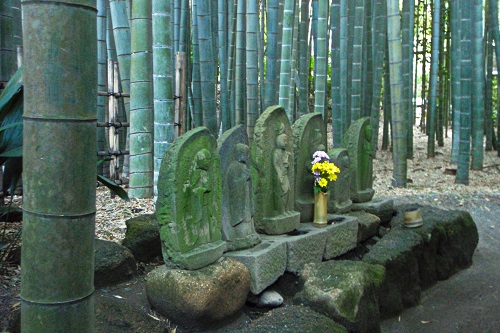As we approach in the pre-dawn gloom, the foreboding metal gates of the temple are chained shut, an unexpectedly tangible barrier on our path to enlightenment. Buchi san guides us to an unlocked side gate and we creep into the tranquil gardens, careful not to disturb the air of calm. Among the shadows, silent shapes form into people as we draw nearer. One stretches his limbs in preparation for the zazen ordeal to come while another paces slowly, contemplating the impeccable topiary.
Without a word, the members of this ragtag group gravitate towards the doorway, lining up with perfectly synchronised precision. We follow suit. Seconds later, a Buddhist monk appears and leads us inside the temple. Buchi san's concise instructions echo in our minds, "Copy me, leave your coat, socks and shoes at the door and don't say anything."
Entering The Hall Of The Buddha
The others, all zazen veterans, shed their footwear and outer layers with barely a rustle as we struggle to muffle the unwelcome sound of velcro and zips. Padding across to the bench bordering the Butsuden, Hall of the Buddha, the chill of this December morning begins to bite our unprotected feet.
Making full use of the cushions provided, we settle into place, carefully avoiding the cold wood. We do our best to get comfortable in a vague approximation of the lotus postion while the monk opens the many paper screen windows and sliding doors. Our surprise at this unexpected development is quickly swept away in a rush of icy winter air as we start to fear for our rapidly cooling extremities.

Zazen Part 1: Silent Contemplation
The first part of our zazen meditation is silent contemplation. We all sit at peace under the unblinking gaze of the Buddha statue that dominates the room. Eyes partially closed, we calm our minds and control our breathing. The aim is to suspend judgemental thinking, simply observing and accepting things as they are. A sharp strike of the gong signals the end of the first segment, followed closely by a unified sigh of relief and a shuffle as everyone subtly tries to stimulate their circulation during the brief respite.
Zazen Part 2: The Monk's Ministrations
During part two, the monk slowly paces the room, ready to assist us with our concentration via the medium of a hefty stick. Those capable of maintaining their meditations continue in peace but I feel my mind start to wander. Through half closed eyes I see some of the others put their hands together and bow their heads as the monk approaches, a request for his ministrations. I assume the position and two meaty thwacks get my meditation back on track.
Zazen Part 3: Chanting
Another gong, another sigh and another shuffle. The others take out their books ready to join the ritual chanting that forms the final part of our zazen experience. Without books, or the ability to read these chants, we continue to sit and let the sound of the Buddhist verses wash over us.
When the last gong signals the end of the ritual, there is a moment of calm tranquility before the cascade of supressed thoughts comes flooding back amidst the pins and needles of our freshly unfolded legs. After taking a moment to adjust, we each gather our belongings and one by one make a wordless departure.

Later, we bombard Buchi san with questions about the meaning and practice of zazen. "I've been going for more than a year and there are many things I don't understand. No one speaks so I can't ask any questions. I just accept that it happens this way." Perhaps he is closer to enlightenment than we thought.
In winter, zazen can be fairly chilly. We had to remove our coats, shoes and socks and the monk then opened all of the doors and windows. Wear lots of layers and multiple jumpers.
Where To Try Zazen In Kamakura
We tried zazen at Engakuji temple in Kamakura. Gyoten zazen practice is held at 6am daily (except 1st - 7th January and 1st - 5th October). Admission is free.
Take a train from Tokyo to Ofuna station in Kamakura. From Ofuna, take the JR Yokosuka line to Kita Kamakura. Engakuji is next to the station.
